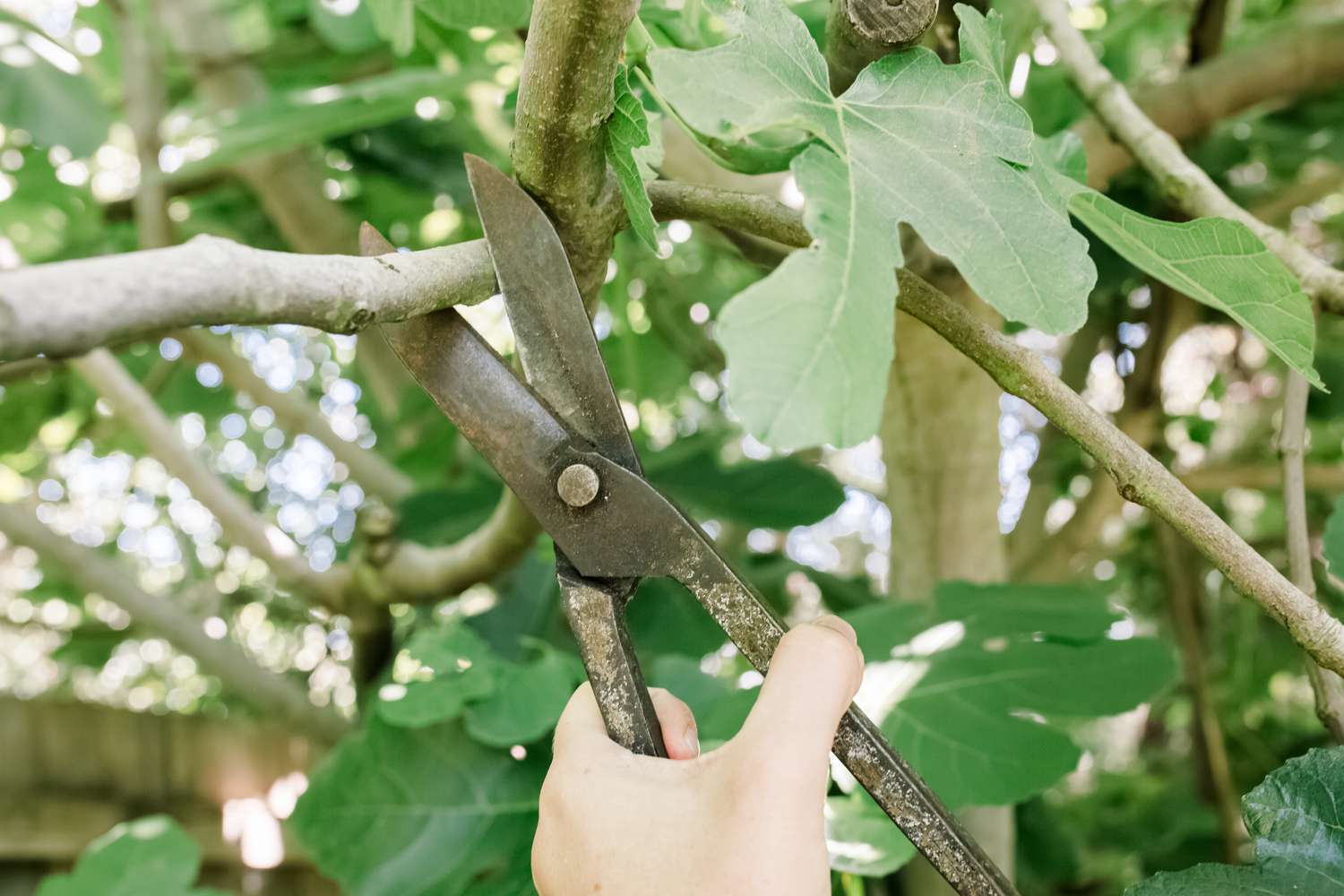Pruning fig trees is an essential part of looking after the tree. Experts say that you should prune the tree twice a year, once in the summer and once in the winter. At least once a year, during the dormant season (winter), you should do it.
The trees won’t get a nice crown, will be more likely to get diseases, and will produce fewer fruits if you don’t prune them often. This article will tell you when and how to prune fig trees in the winter, summer, first, second, and subsequent years. It will also tell you which tools work best.
Figs are easy to grow and quite tasty when ripe making them a popular fruit tree for home gardens. Proper pruning is essential to keep fig trees healthy and productive. While dormant season pruning in winter is key summer pruning is also an important task. Here is a guide to summer pruning your fig trees, why it’s beneficial, and how to do it correctly.
Understanding Fig Tree Growth and Fruiting Habits
Before delving into summer pruning, it helps to understand how fig trees grow and produce their fruit:
-
Figs grown outdoors in suitable climates are deciduous, losing their leaves in fall and going dormant in winter.
-
The fruits develop on the previous year’s wood meaning branches that grew the prior summer will bear the figs in the current year.
-
Figs produce two crops per season – the main crop on old wood then a smaller late crop on new growth.
-
Left unpruned, fig trees grow quickly and can reach 10-30 feet tall and wide.
-
Their fast growth leads to dense foliage and interior branches that don’t get adequate light or air circulation.
Why Summer Pruning is Advised
Pruning once when the tree is dormant isn’t enough – pruning when the fig is actively growing in summer provides additional benefits:
-
Removes current year’s unwanted growth that blocks light and air from reaching developing figs.
-
Thins out interior branches and foliage to open up the canopy and prevent disease.
-
Controls size and shape on fast growing varieties.
-
Allows sunlight to penetrate which improves fruit ripening.
-
Cuts back excess shoots to balance growth.
-
Increases air circulation and decreases fungal issues.
When to Prune Fig Trees in Summer
Aim to summer prune figs:
-
In early to mid-summer, June-July in most zones.
-
After the first crop of figs forms and begins to ripen.
-
Before the second late crop sets fruit in late summer.
Pruning too early in spring risks damaging emerging figs. Pruning too late removes wood that will bear next year’s crop.
How Often to Summer Prune Fig Trees
-
Vigorous growers that put out a lot of dense growth each year benefit from summer pruning annually.
-
Slower growing fig varieties only need occasional summer pruning every 2-3 years.
-
Container figs usually require more frequent summer pruning to control size.
How to Summer Prune a Fig Tree
Follow these steps for summer fig tree pruning:
1. Remove Unproductive Growth
-
Cut out any diseased, dead, broken, or rubbing branches.
-
Take out shoots growing straight up or downward that won’t bear fruit.
-
Thin congested areas and crisscrossing branches to open the center.
2. Shorten Extension Growth
-
Cut current season’s growth back by at least one-third.
-
Prioritize thinning and shortening vertical shoots.
-
Remove or cut back growth shading developing figs.
3. Shape and Contain Growth
-
Prune to encourage an open vase shape, widening as it grows taller.
-
For container figs, prune to limit size and direct growth inward.
-
Make cuts just above an outward facing bud or side shoot.
4. Clean Tools and Paint Cuts
-
Disinfect pruning tools before use to prevent disease spread.
-
Paint any large pruning cuts with tree sealant to protect from infection.
What to Avoid When Summer Pruning Figs
Some key don’ts when pruning figs in summer:
-
Don’t remove more than one-third of the tree’s total growth when summer pruning.
-
Avoid pruning too heavily right before dormancy in fall.
-
Don’t leave stubs when shortening branches – cut back to just above a bud.
-
Don’t prune heavily after fruit sets – you’ll remove next year’s fig-bearing wood.
-
Never summer prune during the plant’s hottest, most stressful periods.
Signs Your Fig Tree Needs Summer Pruning
Watch for these cues that your fig needs some summer pruning:
-
Getting very large and unruly.
-
New growth is mostly upright and forms a densely packed interior.
-
Lower and interior branches are losing vigor and going bare.
-
Fig clusters are shaded by new shoots above them.
-
You notice disease, mildew, insects, or fungal issues.
-
Fruit on current year’s growth doesn’t ripen properly.
Tools for Summer Fig Tree Pruning
You don’t need fancy equipment to tackle summer pruning:
-
Bypass hand pruners – For cutting back shoots up to half inch diameter.
-
Loppers – For thicker branches up to 1.5 inches diameter.
-
Pruning saw – For old wood over 2 inches across.
-
Disinfecting spray – Prevent disease spread on tools between cuts.
-
Tree sealant – Coat large wounds to protect from infection.
Benefits of Summer Fig Tree Pruning
Summer pruning your fig trees provides many advantages:
-
Helps contain fast growing varieties within available space.
-
Allows more light and air to reach developing figs.
-
Removes unattractive and unproductive new shoots.
-
Reduces fungal disease issues like rust and leaf spot.
-
Stimulates fruit bud development for the following year.
-
Improves fruit quality, size, color, and ripeness.
-
Extends the productive lifespan and health of fig trees.
-
Makes it easier to harvest ripe figs without damaging branches.
Enjoy Sweet Summer Figs Thanks to Proper Pruning
Paying attention to pruning your fig trees at the right times of year results in healthy trees and abundant fruit. While winter dormant pruning establishes structure and form, summer pruning keeps trees vigorous and figs thriving in the heat of the growing season. Follow these summer pruning guidelines and you’ll be rewarded with a bountiful fig harvest.
Step 3 – Trimming And Shaping
This is the last step, and it’s easy because all you need to do is style, trim, and shape the crown gently so that it’s about even. Start from the outside and cut towards the trunk. The goal of this step is to create thicker and shorter branches. Prune about 1/3 of last year’s growth on about 1 cm above the chosen bud.
Pruning also depends of how old is your tree.
First-year pruning is made in order to form a tree crown. Remove just one or two branches that are growing towards the center of the crown. Start with forming a tree crown in a vase shape. One branch, the one growing toward the middle of the crown, was pruned as shown in the picture below:
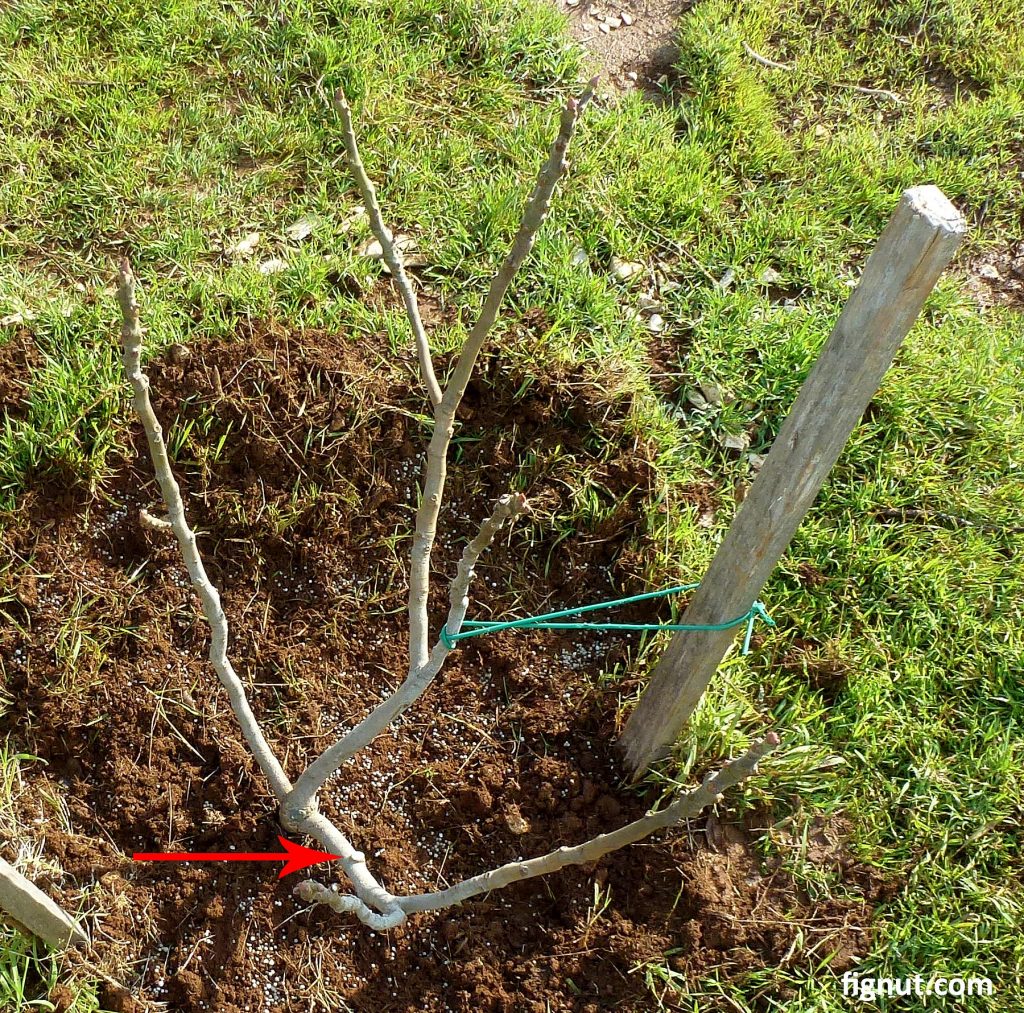
In its second year, trees are just a bit larger, still not mature trees. As you did the first year, clean off all the dead branches in the winter and then carefully thin, trim, and shape the tree even more.
Third Year and Further Pruning
The tree is fully grown after three years and should be producing some fruits that will ripen into soft, sweet, brightly colored figs that are great to eat or dry. Now is the time to start pruning the trees carefully in the winter and summer. From now on, do it the way I said above every year.
It’s been a while since I pruned my fig trees, which are three years old and one year old right now. The bigger and older trees needed more pruning than the smaller and younger ones, as you can see in the pictures.
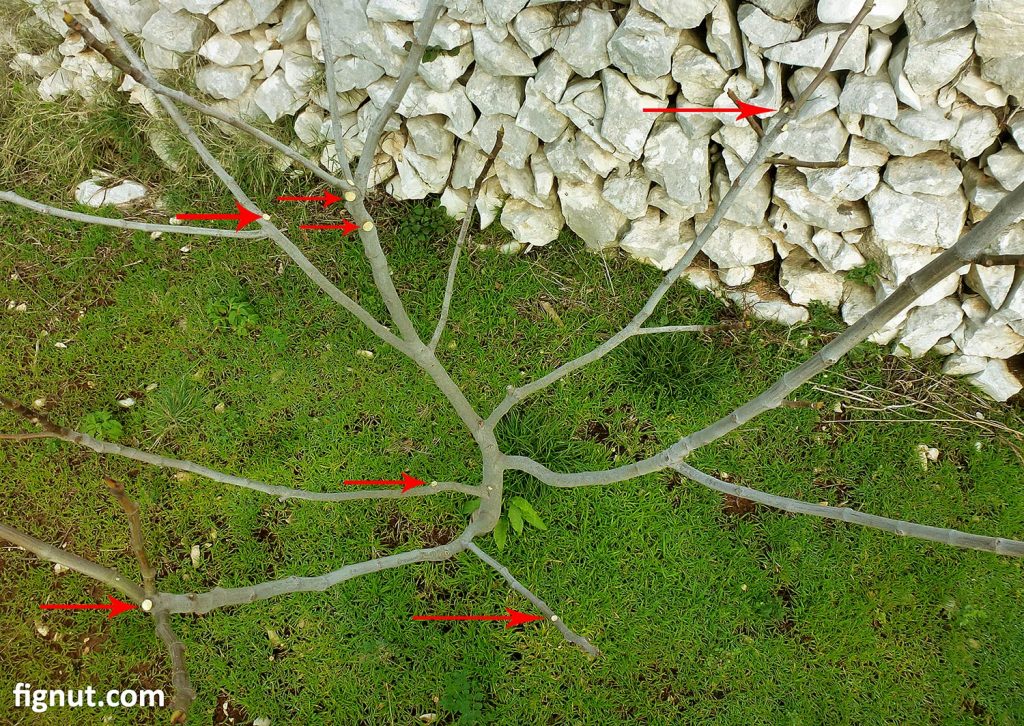
Here are the pruning cuts I made last year and this year. You can see that the cut from last year is already healed and covered in bark for safety. This year’s cut is slowly turning brown and will hopefully heal too.
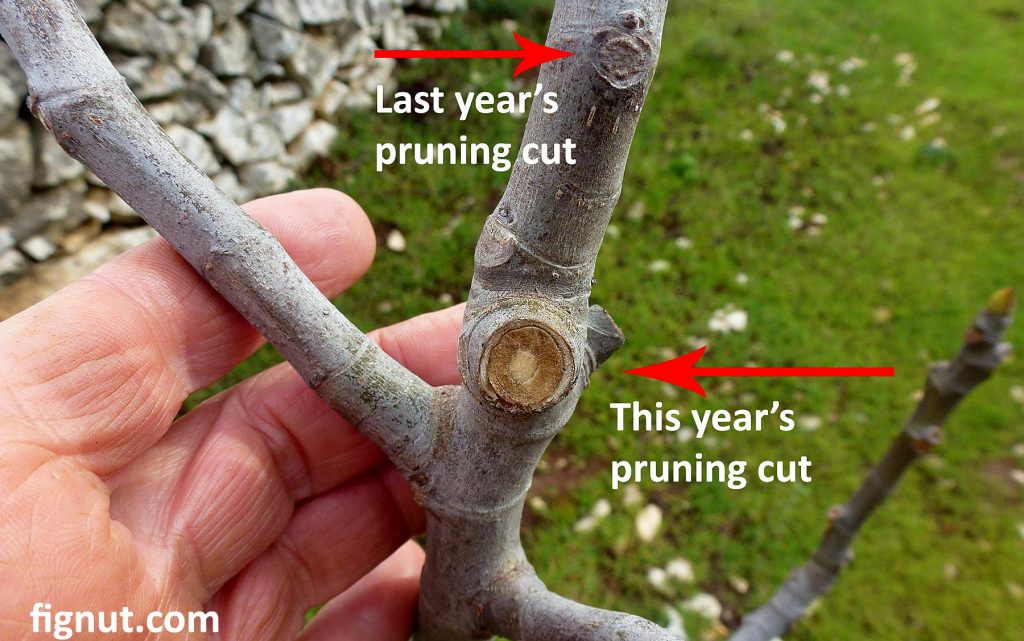
Some of my trees will also need to be bowed, which means that the branches will need to be pushed into a right angle to the trunk. I’m going to do it this year. To turn the branches into the right angle (about 60 to 70 degrees), I’m going to use water bottles as weights.
In late spring and summer, summer pruning, also called “green pruning,” gets rid of water sprouts, which drain the tree and don’t produce any fruit. Keep an eye out for any of these on your tree and cut them off as soon as you see them. Also, remove any leaves that are touching the others in order to control diseases and pests. Summer pruning should be quick and gentle, and you should only cut off leaves or branches that you have to. Leave hard pruning for the dormant period.
You don’t need a lot of expensive tools to prune. For smaller branches, use garden scissors, also called pruning shears. For bigger branches, use garden loppers. You can also use a pruning saw to cut off a very thick branch, but the cut might not be very clean. The bypass loppers are the best tool for cutting back thicker branches because they make very clean cuts.
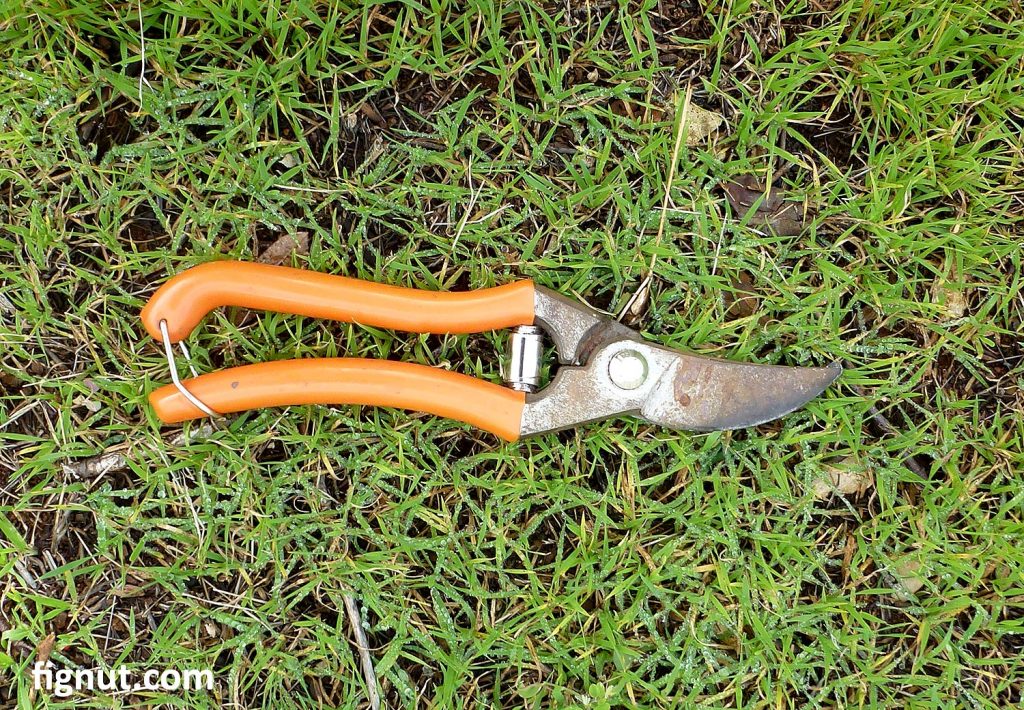
Watch this video to see me prune my fig trees in the winter. I get rid of some dry branches, shoots that grow from the trunk, and shoots that grow from inside the tree.
Summer (Rivers) Pruning Fig Trees for Increased & Timed Harvests
FAQ
What month do you prune fig trees?
How do you take care of a fig tree in the summer?
Do figs fruit on new or old wood?
Should fig trees be pruned in summer?
So, while you can prune fig trees in summer, and light pruning in early summer is sometimes encouraged, pruning (especially heavy pruning) is best left for dormant months. If you do decide to prune fig trees in summer, one thing to note is that fig trees produce fruit on new spring growth as well as the previous year’s new growth.
How often should a fig tree be pruned?
Two pruning cuts on the young fig tree The fig tree should be pruned twice a year. A combination of winter and summer pruning is the most effective. Winter pruning is done usually in late January or February (depending on the climate) when the fig tree is in the dormant phase.
How do you prune a fig tree?
Trim the tree back by half. During the first pruning, you need to clear away a large portion of wood. This is an important aspect of training pruning. By cutting away so much of the fig tree, you force it to focus on developing strong roots. As a result, the tree will establish itself better and be stronger in the long-run.
When can I cut back my fig tree?
Especially as it gets colder outside. “When can I prune, trim, or cut back my fig tree?” Fig trees can be cut at any time, but the most ideal time to prune fig trees is when they are dormant. For more fig-related content like this, feel free to subscribe to the Fig Boss monthly newsletter at the top of the page.
- The Ultimate Guide to Growing Strawberries in Raised Beds - August 8, 2025
- No-Dig Garden Beds: The Easiest Way to Grow a Beautiful Garden - August 6, 2025
- How to Protect and Preserve Wood for Raised Garden Beds - August 6, 2025

